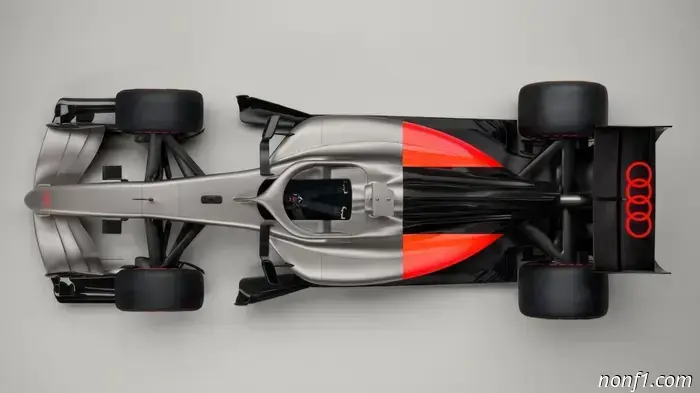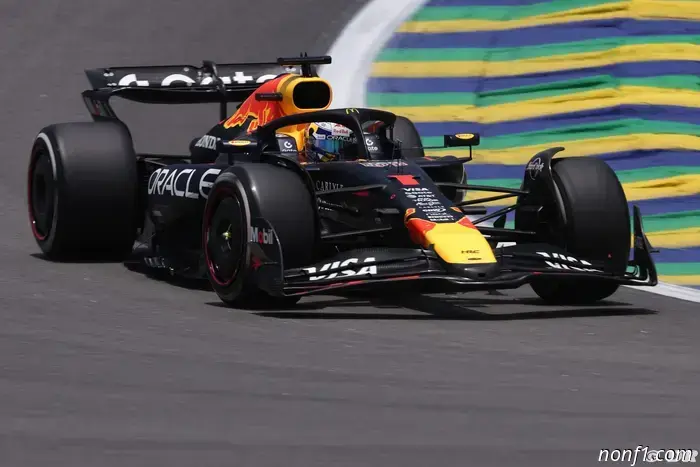
How Audi Leveraged Decades of Racing Dominance to Create Its First F1 Car
The latest in car news and reviews, straightforward and to the point.
Our daily newsletter, which is free, delivers the most significant stories right to your inbox every weekday.
When you're Ferrari, your Formula 1 car is predominantly red. When you're Mercedes, it's mostly silver. For other teams with a rich history in F1, the approach is to draw inspiration from past designs (like McLaren’s Papaya Orange), sprinkle in some modern elements to keep it fresh, and finish it off. But what approach should a new team take? This is the challenge Audi encountered as it set out to create its first-ever F1 car.
Audi introduced its new F1 contender, the R26, on Wednesday, showcasing how a livery composed of simple shapes and three primary colors (arguably two, since “black” is mostly a dark carbon weave) can result in a striking racing vehicle. Despite Audi's lack of recent involvement in motorsport, it’s worth noting that no Formula 1 car has ever borne the four rings emblem before. The pre-war Auto Union Grand Prix cars don't count as F1 cars simply because the Formula One World Championship started only in 1950.
So, how did Audi's design team craft a livery that honored the company's illustrious racing past while also pushing into the future? The R26 marks a significant shift for the brand—if not a complete rebirth. Marco dos Santos, Audi's lead designer, shared insights into his design process while tackling the daunting task of adorning an F1 racer.
“Our initial starting point was to thoroughly examine our history to comprehend what has contributed to our success in previous racing series, while also considering how we could continue to aim for excellence,” dos Santos stated to The Drive. “This was the first step, followed by figuring out how to build upon that.”
From my perspective, opting for a retro livery and rendering the car liquid silver would have been quite simple—especially since Mercedes' car increasingly incorporates black and turquoise annually and less silver. A design reminiscent of pre-war Auto Union Type C would have likely worked well. However, dos Santos noted that this approach wouldn't have pushed the creative boundaries of his team, and there was a strong desire to explore new ideas alongside the nostalgia for the brand's iconic race cars.
“What has made Audi successful over the years is our constant drive to push boundaries—that's central to our philosophy. Of course, there are strict guidelines to consider when designing an F1 car,” he explained. “The car has a very specific architecture and topography, but we are fortunate that Audi has a wealth of interesting elements from the past to evolve and build upon.”
“We needed to recognize that the race car is primarily a design object—each part of the body serves a purpose, which is why we structured the colors in the way we did. We implemented color blocking. For instance, you can see how the carbon fiber perfectly aligns with the engine cover and the sidepods are highlighted with Audi Lava Red. We aimed for a look that exudes performance engineering while retaining an aesthetic true to the overall spirit of Audi.”
Regarding the colors, the seemingly gunmetal grey in the images is actually a sleek shade called Titanium, which made its debut in the Concept C car in September. It appears on the front wing, nose cone, driver cell, and about 70% of the sidepods. Then, the Titanium transitions to Audi Lava Red, which adds a vibrant touch that will help it stand out on the track and, more importantly, on television. What looks like black is, in fact, a very dark exposed carbon fiber pattern that covers most of the engine cover and the entire rear wing. Finally, the Audi rings on the front and rear are also rendered in Lava Red.
If you recall the remarkable Audi prototypes that dominated Le Mans in the 2000s, you might notice some similarities in the color schemes. However, the approach to displaying these colors is entirely different. Whether it’s the Audi Quattros from WRC, the R18s from Le Mans, the S1 Hoonitron from Gymkhana, or the Q8 e-tron from Dakar, various elements from those historic vehicles are present in the new R26, yet it still retains its own unique identity.
After discussing the serious aspects, I directly asked dos Santos how enjoyable it was to design his first F1 livery. His face brightened.
“It’s incredible. This opportunity is surreal, and it’s an immense honor,” he expressed. “I also have to say that the most exciting part isn’t just being involved in this project, but collaborating with the incredibly passionate F1 people you meet along the way who are intensely focused on different aspects of an F1 car.”
“When it comes to materials, performance, there are people exceptionally skilled at translating concepts from 2D to 3D, matching the character of components, surface finishes, and other car aspects—it’s mind











Other articles
 Webber shows a lack of distance and maturity as Piastri's manager.
Formula 1 | Ralf Schumacher has criticized Mark Webber, alleging that Oscar Piastri's manager has poorly managed the increasing pressure within McLaren as the title (…)
Webber shows a lack of distance and maturity as Piastri's manager.
Formula 1 | Ralf Schumacher has criticized Mark Webber, alleging that Oscar Piastri's manager has poorly managed the increasing pressure within McLaren as the title (…)
 George Russell: In 2026 we'll see more overtakes
George Russell believes that in 2026 we'll see overtakes where previously there were none...
George Russell: In 2026 we'll see more overtakes
George Russell believes that in 2026 we'll see overtakes where previously there were none...
 Binotto: Thanks to the regulations, racing will become more interesting.
Mattia Binotto, head of the Audi F1 project, is confident that thanks to the new regulations the races will become more exciting and competitiveness among the teams will quickly even out.
Binotto: Thanks to the regulations, racing will become more interesting.
Mattia Binotto, head of the Audi F1 project, is confident that thanks to the new regulations the races will become more exciting and competitiveness among the teams will quickly even out.
 "There were no employees present on site at that time."
French authorities are probing a perplexing break-in at Alpine’s Viry-Chatillon facility, amid increasing suspicion that the incident may have been a case of industrial espionage. The unusual intrusion, first reported by Le Parisien, took place late on Monday night around 10 PM, when two unidentified individuals gained entry by breaking a window.
As per police sources cited by French media, the intruders proceeded directly upstairs toward the management and executive offices, forcing open several internal doors before exiting the building only a few minutes later. Importantly, it appears that nothing was taken.
"Nothing was stolen. Everything is fine. There were no employees present on site at that time," a source close to Alpine informed Le Parisien. The Evry public prosecutor confirmed that an investigation is currently in progress. Security footage and fingerprints are being examined, but no arrests have been made as of now.
With theft ruled out, Le Parisien noted: "All other possibilities are being explored, including industrial espionage." L’Equipe pointed out the unusual timing and location: the historic Viry site is no longer involved in designing Alpine’s F1 power units, as the team will be using customer Mercedes engines starting in 2026. Many of the engine staff have already moved to other locations, including Ferrari.
French media also noted that the intruders seemed to know precisely where they were headed, going directly to the senior offices before quickly exiting through a side door. Alpine has not made any public statements beyond confirming the occurrence of the incident.
Formula 1 | Dr. Helmut Marko from Red Bull has candidly acknowledged that Max Verstappen requires a significant setback to occur for Lando Norris if the championship battle is to be…
There has been talk in Formula 1 about the return of the Argentine Grand Prix.
During the São Paulo Grand Prix, Alpine extended Franco Colapinto's contract. British journalist Joe Saward, knowledgeable about Formula 1's business workings, writes that this move could be another link in the chain of efforts to bring back the Argentine Grand Prix.
"There were no employees present on site at that time."
French authorities are probing a perplexing break-in at Alpine’s Viry-Chatillon facility, amid increasing suspicion that the incident may have been a case of industrial espionage. The unusual intrusion, first reported by Le Parisien, took place late on Monday night around 10 PM, when two unidentified individuals gained entry by breaking a window.
As per police sources cited by French media, the intruders proceeded directly upstairs toward the management and executive offices, forcing open several internal doors before exiting the building only a few minutes later. Importantly, it appears that nothing was taken.
"Nothing was stolen. Everything is fine. There were no employees present on site at that time," a source close to Alpine informed Le Parisien. The Evry public prosecutor confirmed that an investigation is currently in progress. Security footage and fingerprints are being examined, but no arrests have been made as of now.
With theft ruled out, Le Parisien noted: "All other possibilities are being explored, including industrial espionage." L’Equipe pointed out the unusual timing and location: the historic Viry site is no longer involved in designing Alpine’s F1 power units, as the team will be using customer Mercedes engines starting in 2026. Many of the engine staff have already moved to other locations, including Ferrari.
French media also noted that the intruders seemed to know precisely where they were headed, going directly to the senior offices before quickly exiting through a side door. Alpine has not made any public statements beyond confirming the occurrence of the incident.
Formula 1 | Dr. Helmut Marko from Red Bull has candidly acknowledged that Max Verstappen requires a significant setback to occur for Lando Norris if the championship battle is to be…
There has been talk in Formula 1 about the return of the Argentine Grand Prix.
During the São Paulo Grand Prix, Alpine extended Franco Colapinto's contract. British journalist Joe Saward, knowledgeable about Formula 1's business workings, writes that this move could be another link in the chain of efforts to bring back the Argentine Grand Prix.
 Verstappen only regrets the incident in Barcelona.
Reflecting on the course of the 2025 season in an interview with Viaplay, Max Verstappen expressed regret about the incident in Barcelona...
Verstappen only regrets the incident in Barcelona.
Reflecting on the course of the 2025 season in an interview with Viaplay, Max Verstappen expressed regret about the incident in Barcelona...
How Audi Leveraged Decades of Racing Dominance to Create Its First F1 Car
The designer responsible for the R26's livery describes the challenge of honoring Audi's classic race cars while also crafting a design that was innovative and distinctive on the grid.
